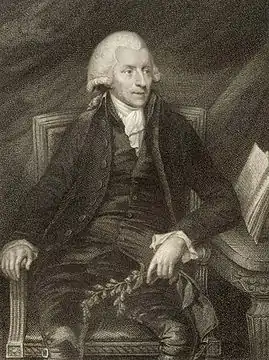Вільям Візерінг
Вільям Візерінг (англ. William Withering[6][7][8], 17 березня 1741 — 6 жовтня 1799) — британський[6][7] (англійський) ботанік[7][8], міколог[6], геолог, хімік[8] та лікар[7].
| Вільям Візерінг | |
|---|---|
| англ. William Withering | |
 | |
| Народився |
17 (28) березня 1741[1][2] Wellingtond, Велика Британія |
| Помер |
6 жовтня 1799[1][2][3] (58 років) Бірмінгем, Ворикшир, Англія, Королівство Велика Британія ·туберкульоз |
| Поховання | St Bartholomew's Church, Edgbastond |
| Країна |
|
| Місце проживання |
Велика Британія Astond |
| Діяльність | ботанік, лікар, птеридолог, бріолог, міколог, фізик, хімік, геолог |
| Галузь | ботаніка, геологія, хімія і медицина |
| Alma mater | Единбурзький університет |
| Знання мов | англійська[1] |
| Членство | Лондонське королівське товариство |
| Батько | Edmund Witheringd[4] |
| Мати | Sarah Hectord[4] |
| У шлюбі з | Helena Cookesd[4] |
| Діти | William Witheringd[4], Charlotte Witheringd[4] і Helena Witheringd[4] |
| Нагороди | |
Біографія
Вільям Візерінг народився 17 березня 1741 року у Веллінгтоні, Шропшир[8].
У 1762 році у віці 21 року він вступив до Единбурзького університету[8].
У 1775 році Візерінг скориставшись списком з 20 трав, які нібито застосовувала знахарка графства Шропшир, вирішив перевірити їхню дію. Результатом цього експерименту було відкриття наперстянки, або дигіталісу.
Вільям Візерінг помер від туберкульозу в Бірмінгемі в жовтні 1799 року у віці 58 років[8].
Наукова діяльність
Вільям Візерінг спеціалізувався на папоротеподібних, мохоподібних, водоростях, насіннєвих рослинах та на мікології[6].
Публікації
- 1766: Dissertation on angina gangrenosa[9].
- 1773: Experiments on different kinds of Marle found in Staffordshire. Phil Trans. 63: 161—2[9].
- 1776: A botanical arrangement of all the vegetables growing in Great Britain… (two volumes) Publ Swinney, London[9].
- 1779: An account of the scarlet fever and sore throat, or scarlatina; particularly as it appeared at Birmingham in the year 1778. Publ Cadell London[9].
- 1782: An analysis of two mineral substance, vz. the Rowley rag-stone and the toad stone. Phil Trans 72: 327—36[9].
- 1783: Outlines of mineralogy. Publ Cadell, London (a translation of Bergmann's Latin original)[9].
- 1784: Experiments and observations on the terra ponderosa. Phil trans 74: 293—311[9].
- 1785: An account of the foxglove and some of its medical uses; with practical remarks on the dropsy, and some other diseases. Publ Swinney, Birmingham[9].
- 1787: A botanical arrangement of British plants… 2nd ed. Publ Swinney, London[9].
- 1788: Letter to Joseph Priestley on the principle of acidity, the decomposition of water. Phil Trans 78: 319—330[9].
- 1790: An account of some extraordinary effects of lightning. Phil Trans 80: 293—5[9].
- 1793: An account of the scarlet fever and sore throat… 2nd ed Publ Robinson, London[9].
- 1793: A chemical analysis of waters at Caldas[9].
- 1794: A new method for preserving fungi, ascertained by chymical experiments. Trans Linnean Soc 2: 263—6[9].
- 1795: Analyse chimica da aqua das Caldas da Rainha. Lisbon (a chemical analysis of the water of Caldas da Rainha)[9].
- 1796: Observations on the pneumatic medicine. Ann Med 1: 392—3[9].
- 1796: An arrangement of British plants… 3rd ed. Publ Swinney, London[9].
- 1799: An account of a convenient method of inhaling the vapour of volatile substances. Ann Med 3: 47—51[9].
Див. також
Примітки
- Bibliothèque nationale de France Ідентифікатор BNF: платформа відкритих даних — 2011.
- SNAC — 2010.
- Енциклопедія Брокгауз
- Kindred Britain
- IPNI. With..
- International Plant Names Index: William Withering (1741—1799)
- DNB, Katalog der Deutschen Nationalbibliothek: William Withering
- «William Withering (1741—1799): A Birmingham Lunatic» Proc R Coll Physicians Edinb 2001; 31:77—83. visto 28 de junio de 2009
- Sheldon, Peter (2004). The Life and Times of William Withering: His Work, His Legacy'(which was a lot)'. ISBN 1-85858-240-7
Джерела
- Sheldon, Peter (2004). The Life and Times of William Withering: His Work, His Legacy'(which was a lot)'. ISBN 1-85858-240-7.(англ.)
This article is issued from Wikipedia. The text is licensed under Creative Commons - Attribution - Sharealike. Additional terms may apply for the media files.